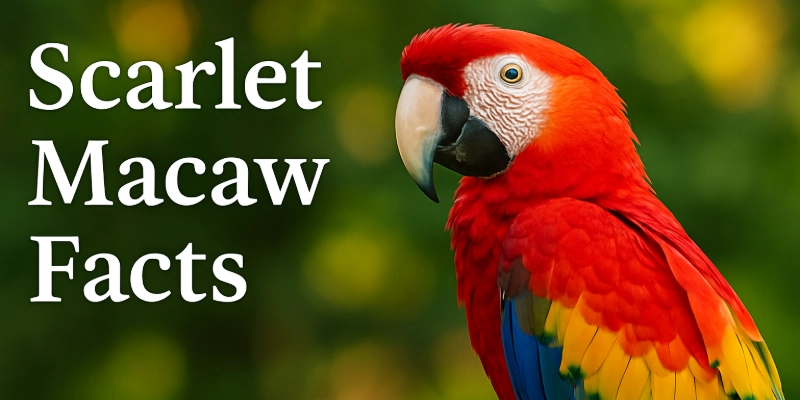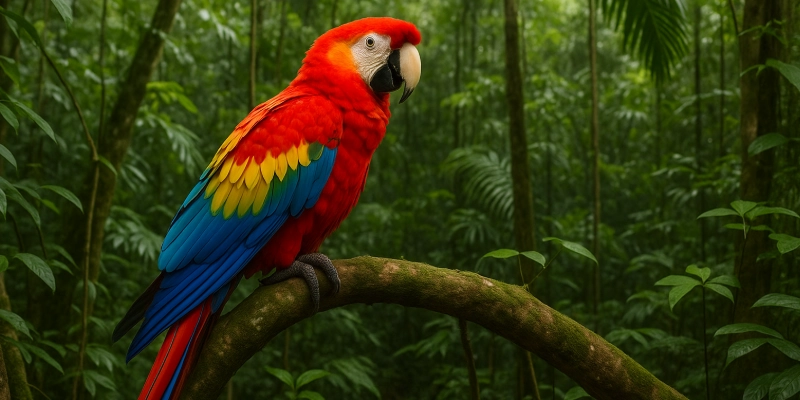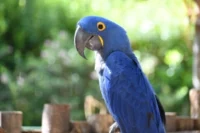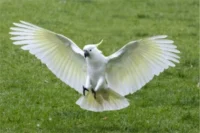Scarlet Macaw Facts File
Published: 27 Jun 2025
The scarlet macaw is one of the most colorful and charismatic birds on the planet. Known for their dazzling plumage, loud calls, and high intelligence, these parrots are true rainforest royalty. But there’s so much more to them than just their looks.
In this scarlet macaw fact file, we’ll dive into different categories that cover everything you need to know from their natural habitat to quirky behaviors.

Whether you’re after scarlet macaw parrot facts or curious about their personality, this guide has it all.
📝 Categories of Scarlet Macaw Facts File
To better understand these stunning birds, we’ve broken down the Scarlet Macaw Facts into easy-to-follow categories.
- Physical Characteristics
- Habitat and Distribution
- Diet and Feeding Habits
- Behavior and Intelligence
- Reproduction and Lifespan
- Conservation Status
- Human Interaction and Pet Trade
- Cultural Significance
- Fun and Unusual Facts
🔍 Physical Characteristics
Let’s start with the scarlet macaw’s most eye-catching features — their body, beak, and brilliant colors.
1. Brilliant Feather Colors
Scarlet macaws are among the most iconic red macaw species, with stunning red bodies offset by yellow and blue wings.
2. Size and Weight
They can grow up to 32 inches (81 cm) long, including the tail, and weigh about 2.2 pounds (1 kg).

3. Powerful Beaks
Their large curved beaks are powerful tools, used for cracking nuts and defending territory.
4. Zygodactyl Feet
They have two toes facing forward and two backward, ideal for gripping branches tightly.
5. Facial Features
Each bird has a unique facial pattern, making identification possible—one of the more overlooked scarlet macaw interesting facts.
🌍 Habitat and Distribution
Next, here’s where these colorful birds live, thrive, and fly freely in the wild.
1. Native Range
This species is native to the humid tropical forests of Central and South America.
2. Preferred Environment
The scarlet macaw habitat includes rainforests, woodlands, and river edges — anywhere with tall trees and ample food.
3. Tree-Dwellers
Scarlet macaws rarely come down to the ground; they feel safest high up in the canopy.
4. Migration
They’re not migratory but will fly long distances daily for food, making them highly active birds.
5. Nesting Altitudes
They nest at elevations between 500 and 1,000 meters, often in tree hollows.
🌿 These scarlet macaw habitat facts highlight the bird’s dependency on undisturbed forest ecosystems.
🥭 Diet and Feeding Habits
What do scarlet macaws love to munch on? Let’s dive into their tropical diet and feeding behavior.
1. Fruit-Lovers
They love tropical fruits like bananas, mangoes, and figs — a common trait among large parrots.
2. Nut Crackers
Their strong beaks let them enjoy hard-shelled nuts, a food source not every bird can access.
3. Clay Licking
One of the more unique scarlet macaw fun facts is their habit of eating clay, which helps detoxify their diet.
4. Occasional Protein
They sometimes eat insects or larvae, although this is rare and more opportunistic than intentional.
5. Foraging Patterns
They usually forage in pairs or small flocks, using their loud squawks to stay connected.
🧠 Behavior and Intelligence
These birds aren’t just pretty — they’re smart, social, and surprisingly emotional. Here’s what you should know.
1. Highly Social
They form lifelong bonds with mates and are very interactive within flocks.
2. Communication Skills
They use a range of vocalizations for everything from warning of predators to calling a mate.
3. Tool Use
These birds have been observed using leaves or sticks, proving their mental agility.
4. Playful Nature
Like many parrots, they enjoy swinging, climbing, and playing with objects.
5. Problem-Solving Abilities
One of the more fascinating scarlet macaw parrot facts is their ability to solve complex puzzles and remember patterns.
🐣 Reproduction and Lifespan
From mating habits to baby chicks, let’s explore how scarlet macaws raise their young and how long they live.
1. Monogamous Pairs
Scarlet macaws usually mate for life, which is rare and touching in the animal kingdom.
2. Nesting Season
They breed during the dry season, laying 1–4 eggs in a safe cavity.
3. Parental Care
Both parents are involved in feeding and protecting the chicks.
4. Fledging Time
Chicks stay in the nest for nearly 3 months and rely on their parents even after leaving it.
5. Long Lifespan
One amazing scarlet macaw fact: they can live over 50 years in the wild and even longer in captivity!
🌱 Conservation Status
Scarlet macaws face a few serious threats in the wild. This section highlights the challenges and efforts to protect them.
1. Threatened by Habitat Loss
With deforestation on the rise, suitable nesting and feeding sites are disappearing.
2. Illegal Pet Trade
Despite laws, scarlet macaws are still taken from the wild to be sold illegally.
3. Conservation Efforts
Many programs now work to reintroduce macaws to their natural environments.
4. IUCN Status
Currently listed as “Least Concern,” but local populations are declining.
5. Local Protection Laws
Some countries enforce strong wildlife protection laws — key to scarlet macaw survival.
This section offers essential scarlet macaw information for anyone concerned with conservation.
👨👩👧👦 Human Interaction and Pet Trade
Humans and macaws have a complicated relationship — especially when it comes to the pet trade. Here’s the reality.
1. Popular Exotic Pets
Due to their beauty, they’re often kept as pets — though not ideal for most households.
2. Not for Beginners
They need space, mental stimulation, and long-term care — factors that many first-time owners underestimate.
3. Talking Ability
While they can mimic sounds, they’re not the best talkers among parrots.
4. High Maintenance
From diet to mental health, they demand a lot of attention.
5. Rescue and Rehabilitation
Thankfully, several shelters and NGOs work to rescue abandoned or mistreated macaws.
🌎 Cultural Significance
Scarlet macaws hold a special place in many cultures, both ancient and modern. Let’s see how they’ve made their mark.
1. Sacred Birds
In ancient cultures, the scarlet macaw was a sacred creature symbolizing the sun.
2. Ancient Artifacts
They appear in ancient South American pottery, jewelry, and ceremonial attire.
3. Mythical Connections
In folklore, they were often messengers between humans and gods.
4. Tribal Ceremonies
Their feathers were worn during rituals and ceremonies.
5. National Symbols
This red macaw is also the national bird of Honduras and a beloved icon in many conservation campaigns.
🎉 Fun and Unusual Facts
Ready for some quirky and cool tidbits? These are the kind of scarlet macaw fun facts that’ll make you smile.
1. Strong Flyers
Scarlet macaws can fly up to 35 miles per hour!
2. Big Personalities
They’re dramatic, vocal, and full of attitude — traits that make them stand out.
3. Excellent Memory
They can remember faces, places, and even basic routines.
4. Emotional Creatures
They show affection, jealousy, and even signs of grief.
5. Daytime Nappers
They nap during the heat of the day, often parched upside-down — one of the more quirky scarlet macaw fun facts!
📌 How to Help Protect Scarlet Macaws
Wondering how you can make a difference? These tips will help you support conservation efforts.
- Support Eco-Tourism: Travel responsibly and visit ethical birdwatching spots.
- Avoid Buying Exotic Pets: Choose admiration over ownership.
- Donate or Volunteer: Get involved with conservation groups.
- Educate Others: Spread awareness using real, up-to-date scarlet macaw information.
Conclusion
Whether you’re a bird lover, a wildlife enthusiast, or just curious, these scarlet macaw interesting facts show there’s more to this parrot than meets the eye. From their powerful beaks to their loving pair bonds, macaws are a species worth knowing and protecting. As one of nature’s most vibrant creations, the scarlet macaw teaches us that beauty, intelligence, and wildness can all coexist in one amazing creature.
If this article touched your heart, don’t keep it to yourself. Leave a comment, share it with your friends, or explore more wildlife stories on our blog!
FAQs
Scarlet macaws are beautiful, intelligent birds but not ideal for most pet owners. They need lots of attention, space, and mental stimulation. Only very experienced bird owners should consider having one.
Scarlet macaws are mainly red with yellow and blue wings, while other macaws vary in color. They also have distinct facial patterns and behaviors. Their habitat and size can differ slightly from other species.
They eat clay to neutralize toxins found in their natural diet. This behavior is common in wild macaws. It helps them digest certain seeds and fruits safely.
In the wild, they live around 40–50 years. In captivity, with proper care, they can live up to 70 years or more. Their long lifespan makes them a big commitment.
Scarlet macaws are not officially endangered but are threatened in some areas. Habitat loss and illegal pet trade are major risks. Conservation efforts are helping protect them globally.

- Be Respectful
- Stay Relevant
- Stay Positive
- True Feedback
- Encourage Discussion
- Avoid Spamming
- No Fake News
- Don't Copy-Paste
- No Personal Attacks

- Be Respectful
- Stay Relevant
- Stay Positive
- True Feedback
- Encourage Discussion
- Avoid Spamming
- No Fake News
- Don't Copy-Paste
- No Personal Attacks





